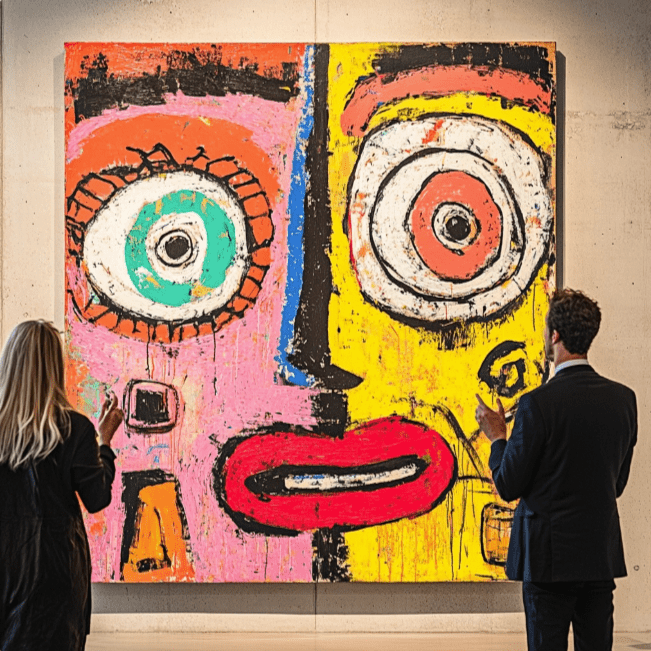Art has been a profound medium of expression throughout human history, encapsulating the evolution of culture, society, and individual thought. Among the myriad forms and styles, understanding the difference between modern and contemporary art is essential for appreciating their unique contributions to the art world. While both are often discussed interchangeably, they represent distinct periods and philosophies within the visual arts. This article delves into their defining characteristics, influential figures, and the role of various art movements and mediums in shaping these two pivotal art eras.
What Defines Modern Art and How Does It Differ From Contemporary Art?
What Are the Key Characteristics of Modern Art?
Modern art is art that emerged during the late 19th and early 20th centuries, a period that stretched roughly from the 1860s to the 1970s. It was characterized by a deliberate departure from tradition and a search for new forms of expression that reflected the rapid changes of modern life. Modern art movements such as Impressionism, Post-Impressionism, Cubism, and Surrealism challenged conventional perspectives and techniques. Artists like Manet, who is often considered a bridge between traditional and modern art, sought to capture the essence of modernity through bold techniques and innovative compositions. Modernism, therefore, was marked by experimentation and a focus on the subjective experience of reality.
How Is Contemporary Art Defined in the Art World?
Contemporary art, on the other hand, refers to art made from the 1970s to the present day. It encompasses a wide range of practices, styles, and mediums, reflecting the diversity and complexity of contemporary life. Unlike modern art, which was primarily concerned with breaking away from tradition, contemporary art often involves conceptual art, digital art, installation art, and performance art, emphasizing ideas and processes over traditional aesthetic values. Many art historians highlight that contemporary art is not confined to a specific style or movement but is rather an ever-evolving dialogue that engages with current societal, political, and technological issues.
What Are the Main Differences Between Modern and Contemporary Art?
The distinction between modern and contemporary art lies primarily in their respective time periods and philosophical approaches. While modern art was a reaction to the industrial revolution and modernism sought new artistic expressions, contemporary art reflects the complexities of the postmodern world and often blurs the lines between different forms of visual arts. The difference between modern art and contemporary art also manifests in their mediums; modern art typically involved traditional mediums like painting and sculpture, whereas contemporary art explores a broader spectrum, including digital and conceptual mediums.

Who Are the Influential Artists in Modern and Contemporary Art?
Who Are Some Pioneers of Modern Art?
Several influential figures pioneered the modern art movement, each contributing to its development with unique styles and philosophies. Impressionists like Claude Monet and Edouard Manet were among the first to break away from academic traditions, focusing on light and color to capture fleeting moments. Later, artists like Pablo Picasso and Georges Braque advanced Cubism, a revolutionary approach that fragmented objects into geometric forms. Surrealists such as Salvador Dalí and René Magritte explored the unconscious mind through dream-like imagery. These modern artists were instrumental in redefining art as a means of personal expression and intellectual exploration.
Which Artists Are Leading Figures in Contemporary Art?
Contemporary art is populated by a diverse array of artists who continue to challenge and expand the boundaries of art. Figures like Damien Hirst and Jeff Koons are known for their provocative and often controversial works that question materialism and consumer culture. Koons, in particular, is famous for his large-scale sculptures and installations that blend high art with popular culture, a hallmark of pop art. Contemporary artists like Yayoi Kusama use installation art to create immersive experiences that engage viewers on multiple sensory levels. These artists, among many others, have redefined what it means to be a contemporary artist in an ever-changing global landscape.
How Have Artists Like Koons Influenced Contemporary Art?
Jeff Koons has significantly influenced contemporary art with his unique approach that combines elements of pop art, conceptual art, and postmodernism. His works often challenge the distinction between high and low art, using everyday objects to create large, brightly colored sculptures that provoke discussion and critique of modern consumerism. Koons' art is a reflection of contemporary society, utilizing humor and irony to address themes of desire, value, and identity. By pushing the boundaries of what art can be, Koons and his contemporaries have opened new avenues for artistic exploration and dialogue.

How Do Different Art Movements Shape Modern and Contemporary Art?
What Role Does Impressionism Play in Art History?
Impressionism played a pivotal role in the development of modern art by challenging the established norms of fine art. This movement, characterized by its emphasis on light, color, and loose brushwork, sought to capture the transient effects of light and atmosphere. Impressionists like Monet and Renoir focused on everyday scenes, often painting en plein air to convey the immediacy of their surroundings. This departure from detailed realism laid the groundwork for subsequent modern art movements, encouraging artists to explore new perspectives and techniques.
How Did Cubism and Surrealism Influence Modern Art?
Cubism and Surrealism were two of the most influential movements in modern art, each contributing to a deeper understanding of abstraction and the human psyche. Cubism, pioneered by Picasso and Braque, deconstructed objects into geometric shapes, offering multiple viewpoints within a single artwork. This radical approach transformed the perception of space and form, influencing a wide range of modern art practices. Surrealism, led by artists like Dalí and Magritte, delved into the subconscious mind, using dreamlike imagery to explore themes of desire and fear. These movements not only shaped modern art but also laid the foundation for future explorations in abstract and conceptual art.
What Are the Hallmarks of Abstract and Performance Art in Contemporary Art?
In contemporary art, abstract expressionism and performance art are significant movements that reflect the diversity and innovation of the current art scene. Abstract art, building on the legacy of modernism, emphasizes the use of color, form, and gestural brushstrokes to convey emotions and concepts without representing real-world objects. Artists like Jackson Pollock, with his dynamic drip paintings, exemplify this approach. Performance art, on the other hand, challenges traditional art forms by using the artist’s body as a medium, often involving audience participation and live action. These movements highlight the continuing evolution and experimentation inherent in contemporary art.

What Role Do Time Periods Play in Modern and Contemporary Art?
What Time Periods Are Associated With Modern Art?
The modern art period is generally associated with the late 19th century to the mid-20th century, a time marked by rapid industrialization and social change. This era saw the rise of modernism, as artists sought to reflect the new realities and experiences of their time. Modern art encompasses a range of movements, from Impressionism in the 1860s to Abstract Expressionism in the 1940s and 1950s. Each movement contributed to redefining the purpose and methods of art, focusing on innovation and the subjective experience of reality.
How Do Contemporary Art and Its Time Periods Differ?
Contemporary art, beginning in the 1970s and continuing to the present day, differs from modern art in its response to the complexities of the globalized world. This period is characterized by a blending of styles and mediums, with contemporary artists often addressing issues such as identity, technology, and globalization. Unlike the relatively linear progression of modern art movements, contemporary art is marked by its pluralism and openness to diverse influences. This reflects the interconnectedness of the contemporary world and the multiplicity of voices and perspectives within the art community.
How Does the Transition Between Two Different Time Periods Affect Art?
The transition between modern and contemporary art periods has significantly affected the evolution of art, as each era responds to the sociopolitical and technological changes of its time. The shift from modern to contemporary art reflects a broader cultural transition from industrialization to globalization, with contemporary art embracing new technologies and media. This transition has allowed artists to explore new forms of expression and engage with a wider audience. The dialogue between these two periods continues to influence current artistic practices, as contemporary artists draw inspiration from modern art while also challenging its conventions.
How Are Mediums Used in Modern and Contemporary Art?
What Mediums Were Predominant in Modern Art?
During the modern art period, traditional mediums such as painting and sculpture were predominant. Artists like Manet and Monet used oil paints to capture the effects of light and color, while sculptors like Auguste Rodin explored form and texture in bronze and marble. The advent of photography also influenced modern art, prompting artists to experiment with perspective and composition. These mediums allowed modern artists to push the boundaries of technique and subject matter, laying the groundwork for future innovations in art.
How Do Contemporary Artists Utilize Different Mediums?
Contemporary artists utilize a wide array of mediums, reflecting the diversity and innovation of modern and contemporary art. Digital art, installation art, and performance art are just a few examples of how contemporary artists expand the possibilities of artistic expression. Technology plays a significant role in contemporary art, with digital tools allowing artists to create interactive and multimedia experiences. The use of unconventional materials, such as found objects and recycled materials, is also prevalent, challenging traditional notions of what constitutes art.
How Has the Medium Evolved From Modern to Contemporary Art?
The evolution of mediums from modern to contemporary art reflects broader changes in society and technology. While modern art primarily relied on traditional techniques, contemporary art embraces new technologies and interdisciplinary approaches. This evolution has expanded the definition of art, allowing for greater experimentation and inclusivity. The shift from static mediums to dynamic, interactive works demonstrates the ongoing dialogue between artists and their mediums, resulting in a rich and varied landscape of contemporary art. This continuous evolution highlights the adaptability of art to reflect and respond to the changing world.
Enhance Your Space with Unique Modern Masterpieces
Are you inspired by the innovative mediums and conceptual depth highlighted in our exploration of contemporary art? You’re not alone! Today’s art enthusiasts are seeking cultural relevance and emotional connections in their artwork. However, finding pieces that resonate with modern themes and fit your unique style can be a challenge. That’s where we come in!
At Rossetti Art, we specialize in canvas prints, original paintings, and modern sculptures that celebrate the spirit of now. Each piece created by Chiara Rossetti brings a personal touch that connects deeply with current social narratives—just like the modern masterpieces discussed in the article. Don’t miss out on the chance to elevate your home decor with breathtaking artwork that speaks to your values and aesthetic. Explore our collection today and find your perfect piece! Act now, and transform your space into a gallery of inspiration!
FAQ
Q: What is the main difference between modern and contemporary art?
A: The main difference between modern art vs contemporary art lies in their time periods and styles. Modern art refers to works created from the late 19th century until the mid-20th century, characterized by a rejection of traditional forms and an embrace of experimentation. Contemporary art, on the other hand, means art made in our lifetimes, reflecting current issues and ideas.
Q: How did modern art emerge?
A: Modern art emerged in the late 19th century as artists began to challenge traditional forms and techniques. Influenced by rapid industrialization and societal changes, modern artists like Cézanne sought new ways of seeing and representing the world, leading to the development of various important art movements.
Q: What are some characteristics of contemporary art?
A: Contemporary art is diverse and encompasses a wide range of styles and mediums. It often includes conceptual and aesthetic differences from earlier forms and may incorporate elements like video art, performance, and digital mediums. It reflects current social, political, and cultural issues.
Q: Who are some famous contemporary artists?
A: Some famous contemporary artists include Damien Hirst, Jeff Koons, and Banksy. Their works of contemporary significance challenge traditional fine art norms and often provoke thought about modern society.
Q: How do art galleries differentiate between contemporary and modern art?
A: Art galleries typically differentiate between contemporary and modern art based on the time period and style of the works. Modern art is often featured in historical retrospectives, while contemporary art exhibitions focus on current and emerging artists.
Q: What role do art institutions play in the history of art?
A: Art institutions play a crucial role in preserving, curating, and promoting both modern and contemporary art. They help educate the public, provide platforms for artists, and contribute to the ongoing dialogue about the significance and evolution of visual arts.
Q: Why is the end of modernism significant in art history?
A: The end of modernism marked a transition to new art forms and philosophies that addressed the changing world. This shift allowed for the development of contemporary art, which embraces a broader range of expressions and techniques, reflecting the complexities of modern life.
Q: How does abstract art fit into the modern and contemporary art narrative?
A: Abstract art emerged as a major element of modern art, challenging traditional representation by focusing on color, form, and line. It continues to be influential in contemporary art, where it is often reinterpreted and combined with other forms to explore new concepts.
Q: What are some important art movements that shaped modern art?
A: Important art movements that shaped modern art include Impressionism, Cubism, Surrealism, and Expressionism. These movements broke away from traditional techniques and paved the way for the diverse approaches seen in contemporary and modern art today.




Leave a comment
This site is protected by hCaptcha and the hCaptcha Privacy Policy and Terms of Service apply.